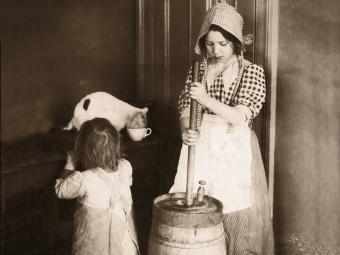
Long car rides, days without power, and end-of-school-year classes are environments made for card playing. For generations, people have been playing all kinds of card games, some of which we still play today. Yet, these antique playing cards that our ancestors used are just as collectible today as they were hundreds of years ago.
With so many artistic and subversive designs, antique playing cards represent just about every social interest and experience from the past, and they're so beautiful that you can't help but want to sit down and a play a round.
Where Do Antique Playing Cards Come From?
History's filled with more questions than answers and playing cards as we know them today have an inconclusive past. Depending on the source, you'll get told that playing cards originated in China as early as the 9th century, introduced to conquered groups by Saracens, or brought by Indian traders to the West. Although we can't pinpoint where and when exactly playing cards were invented, we do know for sure that they're really old.
By the Medieval period in Europe, gambling using playing cards was a common pastime for people of all socioeconomic levels. Kings and queens could throw their bets down just as well as their peasants. Thankfully, there are a few major design changes made over the centuries that you can use to date almost any deck.
Tips for Dating Antique Playing Cards
Take a look at your old playing cards and you'll see a few different illustrations, numbers, and designs. As time passed, playing card styles changed, and you can roughly date a deck of playing cards based on what they look like.
Aces Present?
If you find an ace on your card, then it was printed no earlier than 1765. England started taxing printing card sales in 1765 and used custom ace stamps (though they didn't look much like an ace to begin with) to show that the deck had been paid for.

Designs on the Back of the Cards?
The first traditional playing cards weren't printed with anything on the back. Because they were plain white, cards would get stained by people's fingers. When you held up your hand, your competitors could tell which cards you had based on the stains they knew were on certain ones. Thomas De La Rue & Company solved this problem by printing simple designs on the back of playing cards in the early 19th century.

Corner Numbers and Suits Present?
The small numbers and suit images you see on the corners of most playing card decks today are called indices. These were introduced in the 19th century and patented during the Civil War. This was a game changer since it thwarted cheating by letting gamblers hold their card hands tightly closed instead of fanned out.
Jokers in the Deck?
If you have a pair of jokers in your playing card deck, then your cards aren't older than the mid-19th century. Jokers were first introduced in American decks in 1867 and in British decks in 1880.
Famous Antique Playing Card Companies
Since gambling and other card games were a consistently popular pastime for our ancestors, there were a ton of manufacturers who made them. Some of the more notable ones are:
- Samuel Hart & Co.
- Russell, Morgan & Co.
- Nintendo
- United States Playing Card Company
- B Dondorf
How Valuable Are Antique Playing Cards?
Antique playing cards can be worth as little as $5 a card to as much as $500+ for a single deck. The older the decks are, the more they're worth. Paper goods, especially ones that were meant to be passed between hands every hour on the hour, don't hold up for centuries. If you can find decks from before the 1800s, then you're looking at values in the hundreds. Take this King of Clubs card that was made using a woodblock from the early 18th century which sold on eBay for $384.50.
Additionally, cards with unique or novelty designs are worth more than those with a standard deck design. Collectors like variety and will pay more for a deck they've never seen before. For example, this multi-deck set of antique Japanese playing cards with rare lacquered backs sold for $599 online.
A few things you can look for if you're looking to make an investment on old playing cards include:

- Cards made before the 19th century. They're rare, as not many of them made it intact to the 2000s.
- Complete decks are always valuable. While you can sell cards individually, you'll get more for a complete set.
- Cards in pristine condition have a big appeal. When you're looking at the cards, you want them to be devoid of stains, misprints, and folds or bends.
- Decks of cards that are sealed are rare and valuable. It's not impossible to find antique playing card decks that are still sealed, but it is rare, and it makes those decks more valuable than most.
Bet High on Your Antique Playing Cards
People love collecting antique playing cards for the same reasons that they loved hoarding trading cards in the 90s. There's always a design you've never seen just out of reach, and that compels many collectors to spend big on the cards that pique their interests. Despite their delicacies, antique playing cards still have a round or two left in them yet.







